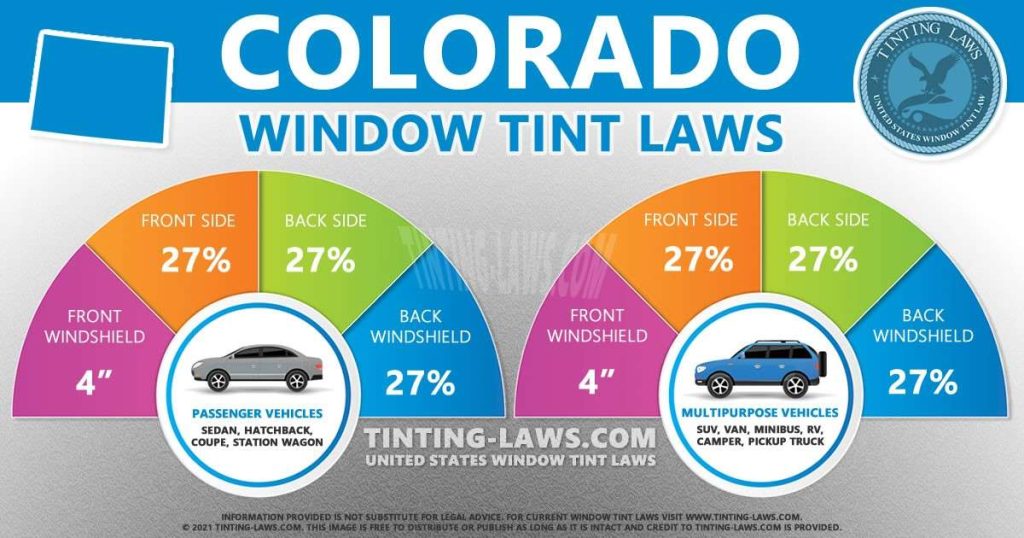Colorado Window Tinting Laws
Car window tinting laws in Colorado were enacted in 1995.
We have provided all the necessary information about your car’s window tint, including how dark or reflective the tint is allowed in your state.
There are also additional car window tinting rules and regulations in Colorado so make sure you read all about it below.
Window tint darkness in Colorado
The percent of visible light allowed through your car windows is called VLT: Visible Light Transmission.
The percentage of light allowed through your film and glass in Colorado is very specific and different for sedan cars and SUV cars or vans.
Tint darkness for sedans:
- Windshield: Non-reflective 70% VLT tint is allowed on the top 4 inches of the windshield.
- Front Side windows: Must allow more than 27% of light in.
- Back Side windows: Must allow more than 27% of light in.
- Rear Window: Must allow more than 27% of light in.
Tint darkness for SUV and vans:
- Windshield: Non-reflective 70% VLT tint is allowed on the top 4 inches of the windshield.
- Front Side windows: Must allow more than 27% of light in.
- Back Side windows: Must allow more than 27% of light in.
- Rear Window: Must allow more than 27% of light in.
If front side windows and windshield have over 70% VLT, windows to the back of the driver (rear window and back side windows) may have any tint darkness.
Window tint reflection in Colorado
Window tint can reflect incoming light and reduce glare and heat.
Colorado window tint law permits a certain window reflection when using a tint so make sure you pay attention to this as well.
Tint reflection for sedans:
- Front Side windows: No metallic or mirrored appearance.
- Back Side windows: No metallic or mirrored appearance.
Tint reflection for SUV and vans:
- Front Side windows: No metallic or mirrored appearance.
- Back Side windows: No metallic or mirrored appearance.
Other Colorado window tint rules and regulations:
Colorado does have several other important laws, rules and regulations pertaining to window tinting. They include the following:
- Side Mirrors: Dual side mirrors are required if back window is tinted.
- Restricted Colors: The tint color(s) of RED and AMBER are not legal by state law.
- Certificates: Film manufacturers don’t need to certify the film they sell in Colorado.
- Stickers: State law recommends but does not require stickers to identify legal tinting.
- Medical Exceptions: Colorado law does NOT allow medical exemptions that would allow you use special tint.
- Penalties: Class B traffic infraction, or misdemeanor with $500-$5000 fine.
Keep in mind that Colorado tinting laws and regulations may be interpreted differently in your county or place of residence.
We always recommend double-checking our information with your local DMV or law enforcement authorities.

Our information about window tint laws in Colorado was last updated in 2024.
Tinting laws in Colorado were enacted in 1995.
In case any of our info provided is not up to date or correct be sure to contact us so we can fix it. Thanks!
Trusted industry leader in providing accurate window tint laws. Share with confidence:
State of Colorado Info
Colorado is a U.S. state encompassing most of the Southern Rocky Mountains as well as the north-eastern portion of the Colorado Plateau and the western edge of the Great Plains.
Colorado is part of the Western United States, the Southwestern United States, and the Mountain States.

Colorado is the 8th most extensive and the 22nd most populous of the 50 United States.
The United States Census Bureau estimates that the population of Colorado was 5,187,582 on July 1, 2012, an increase of +3.15% since the 2010 United States Census.
The state was named for the Colorado River, which early Spanish explorers named the Río Colorado for the red colored (Spanish: Colorado) silt the river carried from the mountains.
Capital: Denver
Population: 5,812,069
Area: 104,094 sq mi (269,837 km2)
Cities in Colorado: Denver, Colorado Springs, Boulder, Fort Collins, Aspen, Vail, Longmont, Breckenridge, Pueblo, Aurora, Grand Junction, Estes Park, Durango, Loveland, Steamboat Springs, Littleton, Greeley, Golden, Telluride, Arvada, Centennial, Broomfield, Castle Rock, Glenwood Springs, Lakewood, Englewood, Westminster, Crested Butte, Thornton, Winter Park, Louisville, Pagosa Springs, Ouray, Parker, Manitou Springs, Salida, Leadville, Nederland, Montrose, Gunnison, Lyons, Lafayette, Alamosa, Cañon City, Buena Vista, Silverton, Frisco, Trinidad, Erie, Fairplay
Counties in Colorado: El Paso, Denver, Arapahoe, Jefferson, Adams, Larimer, Boulder, Douglas, Weld, Pueblo, Mesa, Broomfield, Garfield, La Plata, Eagle, Fremont, Montrose, Delta, Morgan, Summit, Montezuma, Routt, Teller, Elbert, Logan, Otero, Chaffee, Pitkin, Park, Las Animas, Alamosa, Gunnison, Grand, Moffat, Prowers, Archuleta, Rio Grande, Yuma, Clear Creek, Kit Carson, Conejos, San Miguel, Lake, Huerfano, Rio Blanco, Bent, Saguache, Crowled, Lincoln, Gilpin, Washington, Phillips, Ouray, Custer, Baca, Costilla, Sedgwick, Dolores, Cheyenne, Kiowa, Jackson, Hinsdale, Mineral, San Juan